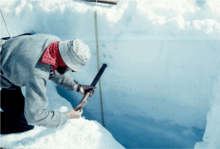Firn


Firn (/fɪərn/; from Swiss German firn "last year's", cognate with before) is partially compacted névé, a type of snow that has been left over from past seasons and has been recrystallized into a substance denser than névé. It is ice that is at an intermediate stage between snow and glacial ice. Firn has the appearance of wet sugar, but has a hardness that makes it extremely resistant to shovelling. Its density generally ranges from 0.4 g/cm³ to 0.83 g/cm³,[1] and it can often be found underneath the snow that accumulates at the head of a glacier.
Snowflakes are compressed under the weight of the overlying snowpack. Individual crystals near the melting point are semiliquid and slick, allowing them to glide along other crystal planes and to fill in the spaces between them, increasing the ice's density. Where the crystals touch they bond together, squeezing the air between them to the surface or into bubbles.
In the summer months, the crystal metamorphosis can occur more rapidly because of water percolation between the crystals. By summer's end, the result is firn.
The minimum altitude that firn accumulates on a glacier is called the firn limit, firn line or snowline.
Other uses
In colloquial and technical language, 'firn' is used to describe certain forms of old snow or harsch:
- Old snowfields or névé (Firnfelder), even if the snow is not yet one year old
- the more recent snow layers of a glacier (a 'firned' glacier)
- the uppermost, soft layer of snow that is frozen overnight and, as a result of spring sunshine and high air temperatures, forms on an area of old snow or harsch (a slope firns up; in Switzerland called Sulz, but this term in Germany refers to a certain depth at which skiing downhill is no longer enjoyable)
References
- ↑ Cuffey and Paterson (2010), The Physics of Glaciers 4th Edition
- USGS Glossary of Selected Glacier and Related Terminology
- Fundamentals of Physical Geography
- Firn definition on Encyclopædia Britannica
- /Greenland Meltwater Storage in Firn Limited